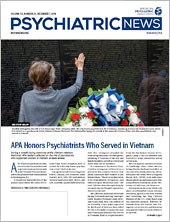Smartphones and other mobile technologies offer a promising portal to increase access to mental health care but how might psychiatrists ensure this technology reaches those in greatest need?
The answer begins with knowing the needs of the patients you are trying to reach, said a diverse panel of experts at this year’s IPS: The Mental Health Services Conference. The panelists have all been exploring the use of technology to support populations who have limited access to care.
As a mental health care specialist at Cambridge Health Alliance, a safety-net health system serving the greater Boston area, Liza Hoffman, M.S.W., knew many patients had long waits times for their initial mental health appointment. She wondered whether mobile health apps might be used as “clinical extenders” for patients waiting for behavioral therapies. In addition to educating patients about mental illness, Hoffman thought the apps might help patients become more engaged about their forthcoming treatment.
She conducted a pilot evaluation with about 50 patients recently diagnosed with a mental illness (primarily depression and/or anxiety). The patients received an iPad preloaded with nine free mental health apps that they could use during their bridge period. All the apps were chosen using the
APA App evaluation tool to ensure they met standards for patient privacy, good usability, and effectiveness.
The patients provided feedback on their app habits, which revealed that tools for self-monitoring symptoms and relaxation/mindfulness techniques were the most popular. The patients also reported that they were comfortable using the apps and in general found them helpful. Hoffman said that these findings show that mobile apps may work well as a preliminary self-help aid before treatment begins.
In Chicago, a project known as Stepping Stones is using smartphones to help connect disadvantaged teens and young adults with mental health professionals. As Niranjan Karnik, M.D., Ph.D., and Dominika Winiarski, Ph.D., an associate professor of psychiatry and postdoctoral fellow at Rush University, respectively, explained, the program gives homeless or transitionally housed youth free smartphones with preloaded mental health apps and access to a trained therapist via phone or text messaging.
The text-based counseling option is often the most popular of the mental health app features used by the youth. According to Karnik, the youth primarily reached out to the counselor for in-the-moment stress management and to deal with interpersonal difficulties.
Winiarski noted that the erratic schedules of these youth made it difficult for them to connect with therapists for longer counseling sessions. In addition, wi-fi access or a place to safely charge the phones was not always guaranteed. She suggested that expanding wi-fi and adding storage lockers at shelters could help keep youth better connected with mental health services.
Digital mental health interventions can help connect people around the world to care, Yale University resident Kunmi Sobowole, M.D., told the audience.
Sobowole has created online psychotherapeutic modules for people in Asian countries that incorporate components of cognitive-behavioral therapy for internet addiction, problem gambling, substance use, and depression.
Working on these online tools, “I’ve learned that we need to better appreciate diversity in non-Western cultures,” he told the audience. Simply translating existing resources is not enough. For example, his work on a depression app in China made him realize the importance of themes such as filial piety (respecting one’s elders) that are not commonplace in the United States. But, if one takes the time to properly adapt these online tools, “you find they can transcend time, space, and culture,” he said.
Past APA President Anita Everett, M.D., who made innovation one of the major focal areas of her presidency, summed up the session by noting, “We are learning that digital health will not replace people, but it can augment care and intersperse care when humans are not available.” ■

